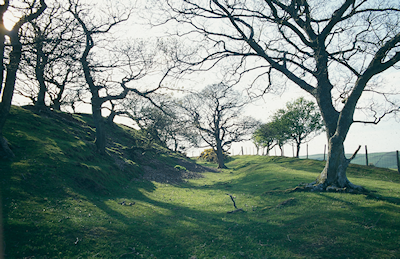
The constructional requirements of a typical hillfort stretched for miles beyond the perimeter of the finished ramparts and we should not underestimate the considerable labour inputs and support networks required by these major building works. When describing the Danebury hillfort in Hampshire, England, Barry Cunliffe (1984) listed the nearly two thousand timbers, each five metres long, required to construct the ramparts, with an equivalent again for cross-bracing and the digging, carting and dumping of over 20,000 cubic metres of rubble. Professor Manning (1999) provided calculations of the resources consumed by timber-faced hillfort defences, estimating for example that a 4-hectare hillfort such as Pen Dinas, Aberystwyth, may have required just over four and a half thousand trees from 76 hectares of land to provide sufficient timber for vertical posts and tie beams. This represents an enormous consumption of resources by only a medium-sized hillfort, requiring extensive woodland management over a wide area, with the builders having access to the timber produced and the labour required to fell the trees and provide haulage (Figure A). There are social implications for ownership and control of the surrounding landscape; the builders would have needed sufficient authority to acquire raw materials for the fort. Labourers would also have required sufficient food and water throughout the day, and accommodation for the night. We must assume nothing less than an impressive organisational structure to manage the logistics of such building projects, and for the work to have been undertaken during stable political periods.

At the same time it is likely that the act of building and creating iconic monumental architecture in later prehistoric Wales played a similar role to the Iron Age chiefly feast, or the 'potlatch' tradition of conspicuous consumption and destruction of wealth at public gatherings, to demonstrate power and acquire status. The more wealth and resources on display during a hillfort-build, the bigger the draw of available labour from farms and forts in the surrounding countryside. People would have been willing to give help and time in return for the future promise of reciprocal help, or indeed to earn protection and a sense of belonging offered by the inhabitants of the fort. The additional excitement — in the rural calendar — of a mass meeting of people fuelled by feasting, alcohol and working towards a single goal no doubt also proved extremely popular. These conclusions were echoed in 2007 by Sharples (2007, 180) in regard to the communal construction of large defended enclosures in first millennium BC Wessex:
'If we regard the construction process as related to the gift of labour and resources, then construction of ever larger and more complicated enclosure boundaries is effectively the conspicuous consumption of resources. Communities were in competition to attract larger and larger numbers of people to help in the process of construction'.
On the ground today visible evidence still exists of the brute strength and dedication required by the Iron Age builders to realise their monumental vision. At upland hillforts particularly, deep ditches cut through the solid rock may still form formidable obstacles, while towering earth and stone ramparts can enclose quite treacherous hilltops, skirting sheer cliffs and narrow promontories. To the best of our knowledge the majority of these building works were completed with basic tools of bone, wood or stone, iron remaining an expensive commodity and not widely employed for tool manufacture until the coming of the Romans. Only by understanding the constructional feat of engineering can we gain new respect for our Iron Age ancestors, and discover a new empathy when we visit these old earthworks in the Welsh countryside.
Internet Archaeology is an open access journal based in the Department of Archaeology, University of York. Except where otherwise noted, content from this work may be used under the terms of the Creative Commons Attribution 3.0 (CC BY) Unported licence, which permits unrestricted use, distribution, and reproduction in any medium, provided that attribution to the author(s), the title of the work, the Internet Archaeology journal and the relevant URL/DOI are given.
Terms and Conditions | Legal Statements | Privacy Policy | Cookies Policy | Citing Internet Archaeology
Internet Archaeology content is preserved for the long term with the Archaeology Data Service. Help sustain and support open access publication by donating to our Open Access Archaeology Fund.